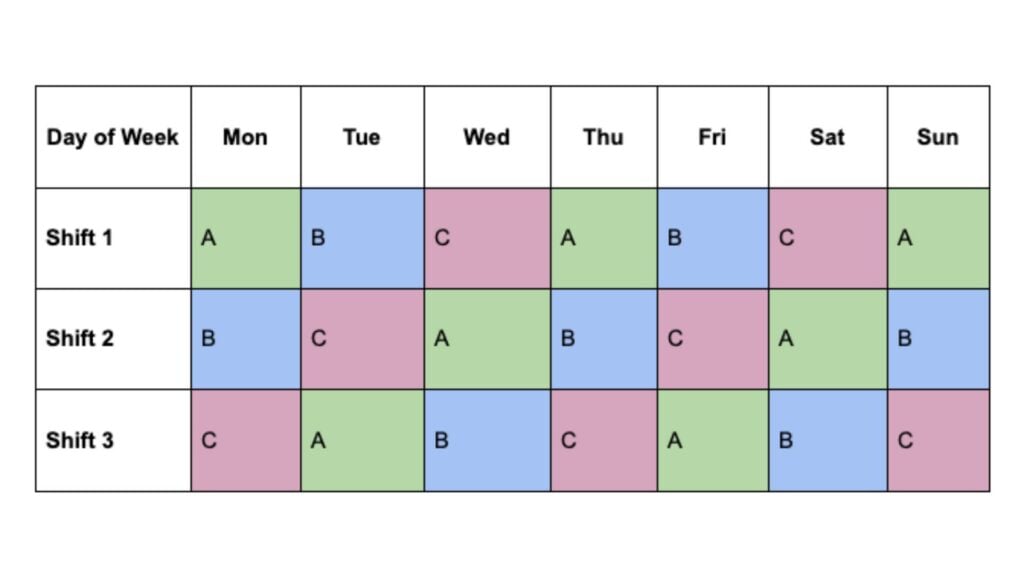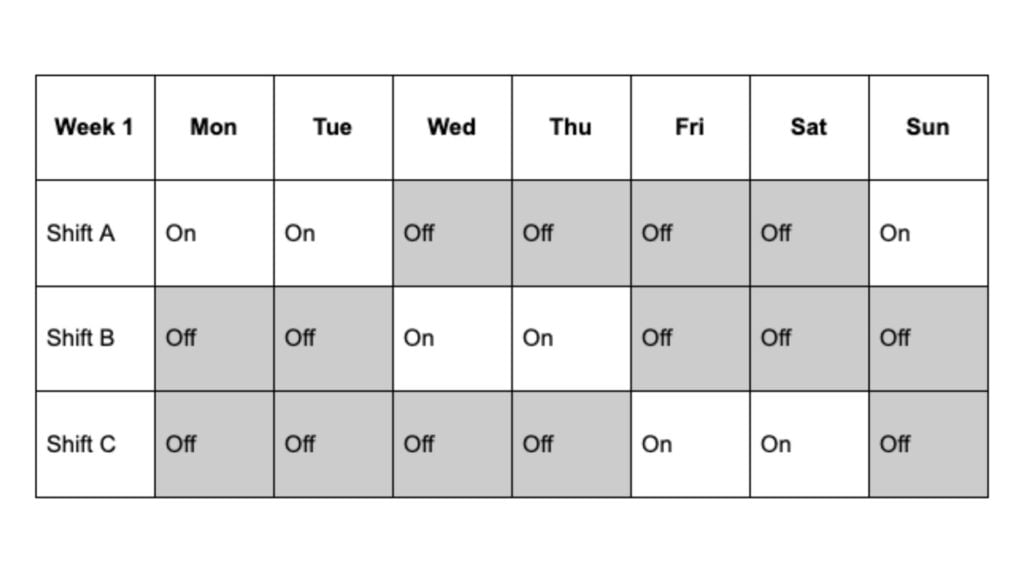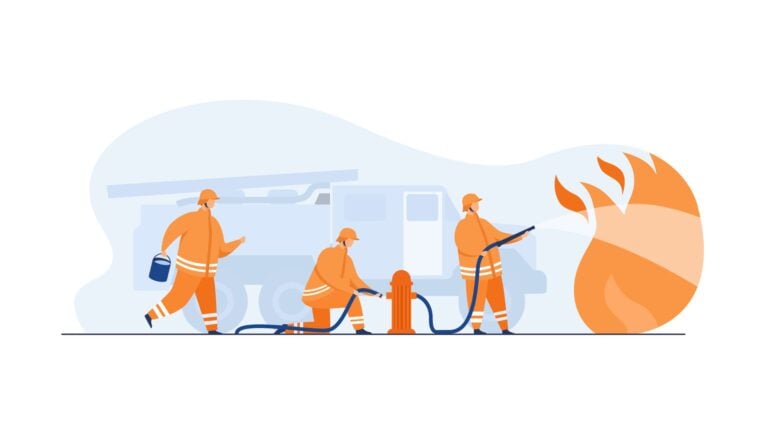Effective firefighter scheduling is crucial for public safety. In this guide, we cover shift types, best practices, and tools to optimize your fire operations.
Firefighter schedules aren’t your typical 9-to-5 arrangement. They often involve extended shifts and complex rotations to ensure round-the-clock emergency coverage—while maintaining a sustainable work-life balance for the team.
In this article, we explore common firefighter schedules and their pros and cons.
Key Takeaways
- Firefighter schedules ensure teams are always ready for emergencies by adopting structured shift patterns such as 24/48 or 48/96, which allow firefighters to remain on-site and prepared for immediate action.
- Effective scheduling is crucial for balancing the intense demands of firefighting with adequate rest and recovery time for personnel.
How Do Firefighter Schedules Work?
Since firefighters must always be prepared to respond to emergencies, firefighter schedules provide 24/7 coverage. This means almost all firefighter schedules are shift-based, which allows departments to stay prepared and manage the physical and mental well-being of their firefighters by giving them time to rest and recover between shifts.
There’s no one-size-fits-all schedule for firefighters. The best schedule often depends on an organization’s size and budget and the community’s needs. This is why firefighter schedules vary widely across departments and other settings.
How do firefighter shifts work?
Firefighter shifts, much like firefighter schedules, vary widely. Since firefighter shifts must provide 24/7 coverage, they occur at various times of the day and are various lengths.
Firefighting shifts are often long. The most common shifts are 24-hour shifts, but some shifts are shorter, and some can last much longer. Departments in rural areas or less busy departments might use 48-hour shifts, for example, to reduce the frequency of shift handovers.
In addition, these shifts often rotate to ease the physical demands placed on firefighters. For example, one firefighter’s shifts might rotate between day and night shifts, or the firefighter might work 24-hour shifts that change days throughout the month. This rotation ensures that no firefighter has to consistently work less desirable or more challenging shifts.
Firefighter roles and how they impact schedules
- Career (full-time) firefighters typically adhere to the regular shift patterns mentioned earlier, providing consistent coverage and stability in staffing.
- Part-time firefighters might be scheduled more flexibly, often filling in gaps or increasing staffing during peak times or for specific events.
- Seasonal firefighters, such as those hired during wildfire season, work under the most demanding schedules, often with extended firefighting shifts during critical periods.
- Volunteer firefighters don’t usually have fixed firefighting shifts unless there’s a high enough call volume to justify this. However, they must be ready to respond when needed.
One volunteer firefighter wrote: “I’m part of a small [volunteer] department of roughly 15 people…Most of us have regular, blue collar day jobs, while others are career first responders in the next town over. Whoever is available to respond to calls for our VFD, does. We don’t have nearly enough call volume to justify shifts.”
Specialized roles and their scheduling
- Hazardous materials (HAZMAT) handling and technical rescue: Teams often remain on-call due to the unpredictable nature of incidents requiring specialized intervention. Their schedules might also include regular duty hours.
- Wildland firefighting and hotshot crews: This seasonal role typically involves intense schedules during peak fire seasons. Hotshot crews, for instance, are deployed for 14-21 day stretches (called “tours” or sometimes “rolls”), working up to 16 firefighting hours a day near the fire line in various types of camps. These intense periods are followed by mandatory days off for recovery before reassignment.
- Emergency medical services (EMS): Often operating on a more regular, shift-based schedule similar to other emergency services, EMS teams within fire departments need to maintain 24/7 availability, with shifts commonly set at 12 to 24 hours.
- Administrative roles: Some firefighters work regular day shifts in administrative roles, managing aspects like training firefighters, overseeing EMS operations, or running public information and fire prevention divisions. These roles typically follow a standard 40-hour workweek.
What do firefighter work schedules look like? What do they do on shift?
A firefighter’s day is structured around various critical activities. Here’s what a typical shift might involve:
- Emergency response: Responding to fires, medical emergencies, accidents, and other calls for help.
- Maintenance and inspections: Checking and maintaining equipment, vehicles, and gear to ensure everything is working.
- Training and drills: Engaging in ongoing training exercises to hone skills and prepare for a range of emergency scenarios.
- Station duties: Performing tasks necessary for the upkeep of the fire station, such as cleaning, cooking, and administrative work.
- Rest and recovery: During longer shifts, firefighters have designated periods for rest and meals—so they can be alert and ready for any emergency.
Types of Firefighter Schedules and How They Work
Here’s an overview of how different firefighter schedules work.
24/48 schedule
The 24/48 schedule is one of the most common work schedules for firefighters. Under this system, firefighters work for 24 hours straight, followed by 48 hours off. This cycle repeats throughout the month, ensuring continuous coverage across all shifts.
Example:
- Day 1: On-duty from 8:00 am to 8:00 am the following day.
- Day 2 & 3: Off duty.
- Day 4: On duty again, and the cycle repeats.
When implementing this schedule, you’ll need to use multiple teams (A, B, and C) to ensure continuous coverage.
Here’s a table representing a 3-shift schedule for a full week, following the 24/48 pattern, with teams A, B, and C.

Pros:
- There’s a steady number of firefighters on duty each day.
- The repeating pattern makes long-term planning more manageable.
- One shift handover per day can minimize operational disruptions.
- In case of absences, finding coverage for a single 24-hour period is typically easier than it is for longer shifts.
Cons:
- Long hours can result in overtime, which you’ll need to budget and manage carefully.
- Managers must implement and enforce policies to manage fatigue during long firefighting hours, especially in high-call-volume stations.
- The schedule can be rough on firefighters.
Did You Know?
Under the FLSA, employees engaged in fire protection may be paid overtime on a “work period” basis ranging from 7 to 28 consecutive days. For example, firefighters are due overtime after 106 hours worked during a 14-day period or 212 hours during a 28-day period.
One firefighter shared, “11 months into my firefighting career and I’ve already missed so many appointments and broken countless plans because I have absolutely zero memory of the days of the week.”
48/96 schedule
In the 48/96 schedule, firefighters work 2 consecutive 24-hour shifts (48 hours total) followed by 4 days off (96 hours).
Example:
- Day 1-3: On duty from 8:00 am on Day 1 to 8:00 am on Day 3.
- Day 3-6: Off duty before returning to work on Day 7.

Pros:
- Each shift provides 2 full days of continuous staffing.
- Shift handovers occur just twice a week instead of daily.
- The 96-hour off period allows for better work-life balance and fatigue recovery.
- The full cycle repeats every 6 weeks, which can simplify long-term planning.
A firefighter shared their experience, “We’re on a 48/96. I’ve been on crews where the 48 drags on and you’re miserable and I’ve been on crews where your 48 is up and it doesn’t even feel like you worked. Just depends who you’re with but the 96 off is a good recovery period for me.”
Cons:
- Shift-swapping involves a larger time commitment, which can be harder to arrange.
- Managing fatigue during the 48-hour shifts—especially in busier stations—can be difficult without effective policies.
- Covering a 48-hour gap for someone who calls out sick can be difficult.
Kelly Day schedule
A “Kelly Day” is a scheduling practice used primarily in fire departments to manage overtime and ensure firefighting hours aren’t excessive. The concept was named after Mayor Ed Kelly of Chicago, who proposed giving career firefighters extra time off to reduce their work hours without affecting their salaries.
How Kelly Days work:
- Scheduled days off: Kelly Days give firefighters days they’re normally scheduled to work off. They occur on a regular but rotating basis.
- Purpose: The primary goal is to reduce the total number of hours worked over that period, helping manage fatigue and decreasing overtime costs.
- Implementation: A firefighter might get a Kelly Day every few weeks depending on the fire department’s policies and union agreements. This day off is in addition to their regular days off.
A worker shared, “My work does a 1-3-2-3 schedule (1 on, 3 off, 2 on, 3 off) with a kelly day once a month. Its amazing always having a 3 day weekend, and the shifts that are 24’s go by FAST. Loving it 🤙🏼”
Pros:
- Can help control overtime expenses by reducing the total number of hours each firefighter works.
- Kelly Days offer extended, predictable breaks that enhance mental and physical recovery.
Cons:
- Integrating Kelly Days into the schedule requires careful planning to maintain coverage without disrupting the regular workflow.
- On Kelly Days, other staff may need to cover shifts, which can lead to temporary understaffing or require calling in off-duty personnel.
Triadic shift system
The triadic shift system is less common but can be effective, especially for smaller departments. Here’s how it typically works:
- Three different shifts rotate over a set period
- Each shift is 8 or 10 hours
- The rotation usually follows a pattern of days, evenings, and nights
Example with 8-hour shifts:
| Shift | Week 1 | Week 2 | Week 3 |
| A | 7am-3pm | 3pm-11pm | 11pm-7am |
| B | 3pm-11pm | 11pm-7am | 7am-3pm |
| C | 11pm-7am | 7am-3pm | 3pm-11pm |
Pros:
- It allows for greater customization of schedules to fit specific departmental needs and activity patterns.
- It’s useful in departments with varying demand cycles.
- Finding coverage for an 8 or 10-hour shift may be easier than it would be for covering a shift of 24 hours.
Cons:
- Managing 3 different shift patterns simultaneously can be highly complex and may require sophisticated scheduling software.
- Ensuring all teams are consistently updated and informed across different shifts can be challenging.
Did You Know?
Connecteam is a shift scheduling software that can help you manage various shift schedules—including highly complex ones. With it, you can create shift schedules in seconds by using templates, duplicating previous shifts, or using the AI scheduler to do the heavy lifting for you.
E. Other variations of firefighting department schedules
Here are some other variations of schedules firefighters shared on Quora.
1-2-1-4
24-hour shift → 2 days off → 24-hour shift → 4 days off
One firefighter wrote, “I work a 1–2–1–4 schedule and love it. It works out to an average of 42 hours per week over an eight-week cycle. While the 24s can be long and tiring, there’s plenty of time to recuperate.”
24-72
24-hour shift → 3 days off
“I work a 24-hour shift,” one firefighter said, “and then have 72 hours off. This is the best schedule for firefighters.”
California swing shift
24-hour shift → 1 day off → 24-hour shift → 1 day off → 24-hour shift → 4 days off
A firefighter describes this schedule with X’s and O’s: “If ‘X’ is a work day and ‘O’ is an off day: XoXoXoooo. It’s a 9 day cycle that doesn’t really match any calendar so we do end up rotating thru all days of the week.”
Best Practices for Managing Firefighter Work Schedules
Let’s look at some practical tips to help you manage your firefighting schedule effectively.
- Ensure your schedules and scheduling practices adhere to all necessary laws and regulations. This includes the FLSA’s overtime requirements. You might also have local laws and regulations that impact you. In Oregon, for example, local regulations state that firefighters’ work hours can’t exceed an average of 72 hours per week over a fiscal quarter.
- Ensure adequate staffing levels. Follow any local laws or regulations, and consider your budget. You might also use the guidelines from the National Fire Protection Association. The organization has published guidelines—including staffing and deployment guidelines—for career fire departments and volunteer fire departments.
- Have a backup plan. Consider implementing a callback system for emergencies. Many departments call back off-duty firefighters during major incidents. Some might employ reserve firefighters. For example, Orange County reserve firefighters receive a pager that alerts them when they’re needed.
- Ensure adequate rest. Give adequate time off between shifts. Also, ensure there’s rest time during longer shifts, and consider implementing monitored rest periods as the US Fire Administration advises.
- Accommodate time off and leave requests. Plan for those seasonal variations in leave requests—think summer vacations, weekends, and holidays. An annual leave bidding process (where firefighters submit their vacation requests early and are granted leave based on a bidding system—for example, a seniority-based system) could be a great way to manage this fairly.
- Have clear policies for overtime distribution. Ensure that overtime opportunities are rotated equitably among all eligible firefighters. Overtime management software like Connecteam can help with this.
- Enable firefighters to trade shifts. Create a clear process for requesting and approving shift swaps. Ensure swaps don’t result in firefighters working excessive consecutive hours, for instance.
- Establish clear communication channels for communicating schedule information. Regularly update your staff on any changes or issues.
- Ensure your firefighters are happy with their schedules. The firefighting profession is facing staffing shortages, so maintaining the firefighters you currently employ is important. Solicit feedback on scheduling preferences and concerns from employees to enhance satisfaction. Consider using a survey app like Connecteam, for instance.
- Give plenty of notice when changing schedules. For major overhauls, consider a phased approach. Be prepared to address concerns and resistance to change.
Final Thoughts on Firefighter Schedule Management
Firefighter schedules are diverse and complex, designed to meet the unique demands of emergency services. From the common 24/48 and 48/96 patterns to the Kelly Schedule and California Swing Shift, each system offers distinct advantages and challenges.
These schedules aim to balance round-the-clock coverage with staff well-being and operational efficiency. Understanding these schedules and their implications is crucial for creating an effective scheduling system that serves your firefighters and the community.
To optimize the firefighters’ scheduling process, consider investing in fire department shift scheduling software like Connecteam. With features like AI scheduling, shift swapping, communication, built-in compliance tools like overtime and break tracking, time off management, and mobile accessibility, Connecteam might be the perfect software to suit your needs.





